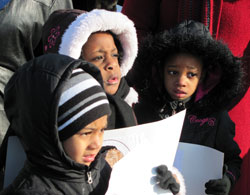2011 Catholic Schools Week Supplement
Video captures legacy of Catholic schools in archdiocese

From left, Holy Angel Catholic School pre-kindergarten students Keirsyn Larsuel, Ashauntey Romain and De’Yana Johnson bundle up for the cold as they participate in the school’s march and program remembering the late Dr. Martin Luther King Jr. on Jan. 14. (Submitted photo)
By John Shaughnessy
It’s an amazing story of commitment, hope and faith that has been in the making for more than 175 years.
It’s the story of Catholic education in the archdiocese, and it’s been concisely captured in a 21-minute video called Our Catholic Schools: A Legacy of Faith and Leadership.
All Catholic schools in the archdiocese have received a DVD copy of the video, which was produced by the archdiocese’s Office of Catholic Education and narrated by Msgr. Joseph F. Schaedel, vicar general of the archdiocese.
The video can also be viewed through the home page of the archdiocese’s website, www.archindy.org, by scrolling down to the “Other Feature” area and clicking on the “2010 video” within the “Celebrating Catholic School Values” section.
Here is a selection of 11 highlights—in chronological order—from the video that show how Catholic education in the archdiocese has grown, thrived and continued as a faith-filled influence in the lives of children.
11. After Servant of God Bishop Simon Bruté established education as one of his priorities in the 1830s, the path for spreading Catholic education in Indiana was greatly extended by Mother Theodore Guérin in 1840 when she came from France to found the Sisters of Providence of Saint-Mary-of-the Woods.
10. At the Third Plenary Council in 1884, Catholic bishops in the United States decreed that all parishes would establish Catholic schools in their parishes within two years. Catholic parents were required to send their children to Catholic schools. During the leadership of Bishop Francis Silas Chatard, 40 new Catholic schools were built.
9. Catholic education continued to expand under the leadership of Bishop Joseph Chartrand from 1918 to 1933. Despite World War I, the influence of the Ku Klux Klan in the 1920s and the stock market crash in 1929, 126 of 147 parishes had elementary schools when Bishop Chartrand died in 1933.
8. “When Joseph Elmer Ritter became bishop in 1934, Catholic education wasn’t open to everyone,” Msgr. Schaedel says in the video. “Four years later, he would start to change that—instructing the Catholic schools to integrate and open their doors to all.”
7. “In 1946, the Greatest Generation was busy creating the Baby Boom Generation and the Catholic population doubled,” Msgr. Schaedel notes. “Archbishop Paul Schulte responded rapidly by opening new parishes and schools, especially in the booming suburbs around Indianapolis and Louisville.”
6. In the 1950s and ‘60s, religious sisters were teaching classes of 60 to 80 students in primary grade classrooms. An increase in religious vocations helped staff the schools during this time. In the mid-sixties, more than 46,000 students were attending 109 Catholic schools in the archdiocese.
5. In 1972, Archbishop George Biskup was “confronted with the most profound changes to affect Catholic education since the 1880s,” Msgr. Schaedel says, when the U.S. Bishops removed the requirement for Catholic parents to educate their children in a Catholic school.
4. More than half of the Catholic schools in the United States were closed by 1980, and those that remained had to learn how to market Catholic schools to parents. “The Archdiocese of Indianapolis became one of the first dioceses in the country to aggressively market Catholic schools,” Msgr. Schaedel states. “The campaign worked and [by 1990] helped reverse a 25-year decline in Catholic school enrollment.”
3. In 1995, Archbishop Daniel M. Buechlein “launched the ‘Making A Difference’ campaign—the first involvement of the archdiocese with the Indianapolis corporate community as partners in supporting Catholic schools. The campaign not only raised $1.4 million to keep the center city schools open, it helped create a lasting relationship with business and government,” notes Msgr. Schaedel.
2. In the late 1990s, the “Legacy of Hope From Generation to Generation” campaign resulted in the renovation of or additions to most Catholic school buildings in the archdiocese, a building boom not seen since the 1960s.
1. “Today, throughout the archdiocese, from center city Indianapolis to rural southern Indiana, the process of Catholic education continues,” Msgr. Schaedel says.
(The Office of Catholic Education is seeking a sponsor to help expand the video into a longer educational version for use in Catholic schools. Anyone interested in a free DVD of the video should call 317-236-1430 or 800-382-9836, ext. 1430.) †
